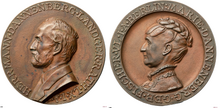Hermann Dannenberg
Friedrich Emil Hermann Dannenberg (born July 4, 1824 in Berlin , † June 14, 1905 in Obersalzbrunn ) was a German numismatist .
Life
Hermann Dannenberg's father was the businessman August Wilhelm Friedrich Dannenberg, born in 1793 as the son of the baker Carl Ludwig Dannenberg and died in 1876/1880, and Hermann's mother was Auguste Pauline Emilie (born 1804 as the daughter of the baker Johann Friedrich Dannenberg).
He started collecting coins at an early age , and soon came to the scientific study of the history of coins. By finding coins he changed medieval numismatics and wrote a work that is still the standard for German coins from the 10th / 11th centuries. Century applies.
With another connoisseur of medieval numismatics , Julius Menadier , he got into a dispute over the minting authority and place of minting of the so-called Otto-Adelheid-Pfennige, which was conducted with personal severity. The issue is explained in the article Sachsenpfennig-Otto-Adelheid-Pfennig .
In 1860 he married Sophie Maria Mathilde Fischer in Berlin, who was born in 1839 as the daughter of the teacher Georg Friedrich Fischer, and had two sons with her, one of whom Arthur Dannenberg became famous as a geology professor at the University of Aachen .
Dannenberg had contributed four articles to the Allgemeine Deutsche Biographie , two of them on lawyers, the other two on numismatists.
Hermann Dannenberg died, almost 81 years old, on June 14, 1905 in Obersalzbrunn. He was buried in the Berlin Cemetery III of the Jerusalem and New Churches in front of the Hallesches Tor . The grave has not been preserved.
Professional background
Dannenberg pursued a legal career full-time: for example, he was appointed court assessor in 1852 , seven years later as a judge at the Berlin City Court, another four years later, in 1863, he was appointed to the City Court Council and in 1879 promoted to the District Court Council .
Honors
There are three medals in honor of Hermann Dannenberg. The first, minted in 1884, shows Dannenberg on the obverse and his wife Marie Dannenberg on the lapel. The reason for the minting was probably the joint birthday - Hermann Dannenberg turned 60, Marie 45, as the circulating legends call it. The medalist was Ferdinand von Brakenhausen .
This also created the second medal. The obverse is very similar to the first copy, but it is not the same stamp. The reverse reveals the reason for this medal: It honors Dannenberg for his 50-year membership in the Numismatic Society in Berlin , which also celebrated its 50th anniversary. Since Dannenberg also gave up his position on the board in the same year, it can be assumed that there will be three possible reasons for the medal.
The last medal minted after his death in 1905 is a commemorative medal that was most likely produced for the commercial market. It was made by the medalist Albert Moritz Wolff at A. Werner & Sons. The reverse is to be understood as an allusion to Dannenberg's work as a numismatist, who was considered an expert on the Middle Ages.
Fonts
- The German coins of the Saxon and Frankish Imperial Era. 4 volumes. Weidmann, Berlin 1876–1905, (digital copies: Volume 1. Text , Volume 1. Tafeln , Volume 2 , Volume 3 , Volume 4 ).
- Fundamentals of coinage (= Weber's illustrated catechisms. 131, ZDB -ID 570761-4 ). Weber, Leipzig 1891.
-
Coin history of Pomerania in the Middle Ages. Weyl, Berlin 1893, ( digitized ; reprint: Zentralantiquariat der DDR, Leipzig 1976).
- Coin history of Pomerania in the Middle Ages. Addendum. Weyl, Berlin 1896, ( digitized ; reprint: Zentralantiquariat der DDR, Leipzig 1976).
-
The coins of German Switzerland at the time of the Saxon and Frankish emperors. In: Revue Suisse de Numismatique . Vol. 11, 1901, pp. 337–423 , (Also as a special print: Jarrys, Geneva 1903. Unchanged reprint: Siemer, Hamburg 1978, ISBN 3-921683-11-4 ).
- The coins of German Switzerland at the time of the Saxon and Frankish emperors. Addendum 1. In: Revue Suisse de Numismatique. Vol. 12, 1904, pp. 5-9 .
literature
- Peter Berghaus : Dannenberg, Hermann. In: New German Biography (NDB). Volume 3, Duncker & Humblot, Berlin 1957, ISBN 3-428-00184-2 , p. 511 ( digitized version ).
Web links
- Works by and about Hermann Dannenberg in the German Digital Library
- Writings by Hermann Dannenberg at Digital Library Numis
Individual evidence
- ^ Hans-Jürgen Mende : Lexicon of Berlin burial places . Pharus-Plan, Berlin 2018, ISBN 978-3-86514-206-1 , p. 240.
- ↑ Stefan Krmnicek, Marius Gaidys: Taught images. Classical scholars on 19th century medals. Accompanying volume to the online exhibition in the Digital Coin Cabinet of the Institute for Classical Archeology at the University of Tübingen (= From Croesus to King Wilhelm. New Series, Volume 3). Tübingen 2020, p. 24 f. ( online ).
- ↑ Stefan Krmnicek, Marius Gaidys: Taught images. Classical scholars on 19th century medals. Accompanying volume to the online exhibition in the Digital Coin Cabinet of the Institute for Classical Archeology at the University of Tübingen (= From Croesus to King Wilhelm. New Series, Volume 3). Tübingen 2020, p. 26 f. ( online ).
- ↑ Stefan Krmnicek, Marius Gaidys: Taught images. Classical scholars on 19th century medals. Accompanying volume to the online exhibition in the Digital Coin Cabinet of the Institute for Classical Archeology at the University of Tübingen (= From Croesus to King Wilhelm. New Series, Volume 3). Tübingen 2020, p. 28 f. ( online ).
| personal data | |
|---|---|
| SURNAME | Dannenberg, Hermann |
| ALTERNATIVE NAMES | Dannenberg, Friedrich Emil Hermann |
| BRIEF DESCRIPTION | German numismatist |
| DATE OF BIRTH | 4th July 1824 |
| PLACE OF BIRTH | Berlin |
| DATE OF DEATH | June 14, 1905 |
| Place of death | Bad Salzbrunn |


